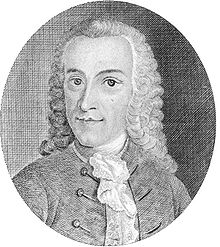Tobias Mayer
| Tobias Mayer | |
|---|---|
 |
|
| Born |
17 February 1723 Marbach am Neckar |
| Died | 20 February 1762 (aged 39) Göttingen |
| Nationality | German |
| Fields | astronomy |
Tobias Mayer (17 February 1723 – 20 February 1762) was a German astronomer famous for his studies of the Moon.
He was born at Marbach, in Württemberg, and brought up at Esslingen in poor circumstances. A self-taught mathematician, he earned a living by teaching mathematics while still a youth. He had already published two original geometrical works when, in 1746, he entered J.B. Homann's cartographic establishment at Nuremberg. Here he introduced many improvements in mapmaking, and gained a scientific reputation which led (in 1751) to his election to the chair of economy and mathematics at the University of Göttingen. In 1754 he became superintendent of the observatory, where he worked until his death in 1762.
His first important astronomical work was a careful investigation of the libration of the moon (Kosmographische Nachrichten, Nuremberg, 1750), and his chart of the full moon (published in 1775) was unsurpassed for half a century. But his fame rests chiefly on his lunar tables, communicated in 1752, with new solar tables to the Königliche Gesellschaft der Wissenschaften zu Göttingen (Royal Society of Sciences and Humanities at Göttingen), and published in their transactions. In 1755 he submitted to the British government an amended body of manuscript tables, which James Bradley compared with the Greenwich observations. He found these to be sufficiently accurate to determine the moon's position to 5", and consequently the longitude at sea to about half a degree. An improved set was later published in London (1770), as also the theory (Theoria lunae juxta systema Newtonianum, 1767) upon which the tables are based. His widow, with whom they were sent to England, received in consideration from the British government a grant of £3,000 (equivalent to £375,000 in 2015). Appended to the London edition of the solar and lunar tables are two short tracts, one on determining longitude by lunar distances, together with a description of the reflecting circle (invented by Mayer in 1752), the other on a formula for atmospheric refraction, which applies a remarkably accurate correction for temperature.
...
Wikipedia
